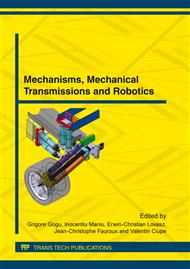[1]
Arai, T., Pagello, E., Parker, L., E., Guest editorial advances in multirobot systems. In: Robotics and Automation, IEEE Transactions on, Vol. 18, No. 5. pp.655-661.
DOI: 10.1109/tra.2002.806024
Google Scholar
[2]
Farinelli, A., Iocchi, L., Nardi, D., Multirobot systems: a classification focused on coordination. In: IEEE Transactions on Systems, Man, and Cybernetics, Part B 34(5): 2015-2028 (2004).
DOI: 10.1109/tsmcb.2004.832155
Google Scholar
[3]
Muñoz-Avila, H. (2002) Case-Base Maintenance by Integrating Case Index Revision and Case Retention Policies in a Derivational Replay Framework. Computational Intelligence. Blackwell Publishers.
DOI: 10.1111/0824-7935.00145
Google Scholar
[4]
Burgard, W. et al. 2000. Collaborative Multi-Robot Exploration., Proc. IEEE International Conference on Robotics and Automation (ICRA), San Francisco CA.
Google Scholar
[5]
Gerkey, B. and M.J. Mataric. 2002. Pusher-watcher: An Approach to Fault-Tollerant Tightly-Coupled Robot Coordination., Proc. of the IEEE International Conference on Robotics and Automation (ICRA2002), Washington DC.
DOI: 10.1109/robot.2002.1013403
Google Scholar
[6]
Lawton, J.R. et al. 2003. A Decentralized Approach to Formation Maneuvers., IEEE Transactions on Robotics and Automation, Vol 19, No 6, 933–941.
DOI: 10.1109/tra.2003.819598
Google Scholar
[7]
Wei, W., Neuro-fuzzy and model-based motion control for mobile manipulator among dynamic obstacles, Science in China Series F: Information Sciences, vol. 46, pag. 14-30, (2003).
DOI: 10.1360/03yf9002
Google Scholar
[8]
Yuchul Jung, Young K. Hwang, Manjai Lee, Case-Based Reasoning Approach to Task Planning of Home-Service Robots, Icat (2004).
Google Scholar
[9]
Yao, Z., Gupta, K., Path planning with general end-effector constraints, Robotics and Autonomous Systems, vol. 55, pag. 316-327, (2007).
DOI: 10.1016/j.robot.2006.11.004
Google Scholar
[10]
Goebelbecker, M.; Keller, T.; Eyerich, P.; Brenner, M.; and Nebel, B. 2010. Coming up With Good Excuses: What todo When no Plan Can be Found.
DOI: 10.1609/icaps.v20i1.13421
Google Scholar
[11]
Schermerhorn, P., Scheutz, M.: Dynamic Robot Autonomy: Investigating the Effects of Robot Decision-Making in aHuman-Robot Team Task (2009).
DOI: 10.1145/1647314.1647328
Google Scholar
[12]
Helms, E.; Schraft, R. D. & Hagele, M. (2002). rob@work: Robot assistant in industrial environments, Proceedings of 11th IEEE International Workshop on Robot and Human Interactive Communication, pp.399-404.
DOI: 10.1109/roman.2002.1045655
Google Scholar
[13]
Iossifidis, I.; Bruckhoff, C.; Theis, C.; Grote, C.; Faubel, C.; Schoner, G. (2002).
Google Scholar
[14]
Bischoff, R. (2001). System Reliability and Safety Concepts of the Humanoid Service Robot HERMES, Proceedings of the First IARP/IEEE-RAS Joint Workshop on Technical Challenge for Dependable Robots in Human Environments.
Google Scholar
[15]
Stopp, A.; Baldauf, T.; Hantsche, R.; Horstmann, S.; Kristensen, S.; Lohnert, F.; Priem, C.; Ruscher, B. (2002).
DOI: 10.1109/roman.2002.1045653
Google Scholar
[16]
Thomas J. Walsh, Sergiu Goschin, Michael L. Littman. Integrating Sample-Based Planning and Model-Based Reinforcement Learning. In Proceedings of AAAI'(2010).
DOI: 10.1609/aaai.v24i1.7689
Google Scholar
[17]
S. Lee, Seung-Min B. and J. Lee (2007). Cognitive Robotic Engine: Behavioral Perception Architecture for Human-Robot Interaction, Human Robot Interaction.
DOI: 10.5772/5195
Google Scholar
[18]
Spalzzi, L. 2001. A Survey on Case-Based Planning. Artificial Intelligence Review, 16(1).
Google Scholar
[19]
Ontanon , S., Mishra, K., Sugandtg, K., and Ram, A. 2007. Case-based planning and execution for real-time strategy games. In Proceedings of ICCBR-2007, p.164–178.
Google Scholar


